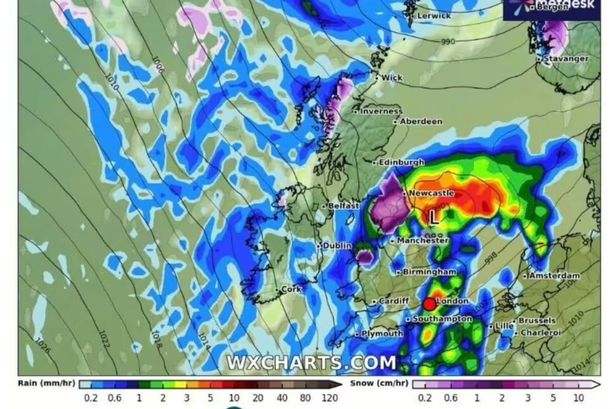The United Kingdom is bracing for a significant shift in weather patterns as an arctic air mass prepares to descend upon the country in the coming days. This frigid incursion is expected to bring a dramatic drop in temperatures, with some regions anticipated to experience lows of -3°C. The plummeting temperatures will be accompanied by the potential for substantial snowfall, with accumulations ranging from 5cm to 10cm predicted in certain areas, particularly those at higher elevations and in northern regions. This sudden shift to wintry conditions marks a stark contrast to the relatively mild weather experienced in recent weeks and will likely necessitate preparations for potential disruptions to daily life, including travel delays, school closures, and potential power outages.
The encroaching arctic air mass is a product of a complex interplay of meteorological factors. A large area of high pressure building over Scandinavia and northern Europe is acting as a blocking pattern, diverting the usual westerly flow of milder Atlantic air and instead channeling frigid air southward from the Arctic regions. This cold air mass is characterized by its low temperature and moisture content, creating ideal conditions for snow formation, especially when it encounters the relatively warmer, moister air over the UK. The intensity and duration of the cold snap will be influenced by the precise track of the arctic air mass and the strength of the high-pressure system steering it southward. Meteorological agencies are closely monitoring these factors to refine their forecasts and provide timely warnings to affected areas.
The anticipated snowfall, though potentially disruptive, is not unprecedented for this time of year in the UK. However, the rapid onset of these wintry conditions, following a period of milder weather, may catch some unprepared. The regions most likely to experience significant snowfall are those in northern Scotland, northern England, and parts of Northern Ireland, particularly areas at higher elevations. Coastal regions are also at risk due to the potential for strong winds whipping up snow into blizzards, reducing visibility and making travel hazardous. Lower-lying areas in southern England and Wales are less likely to see significant snowfall, with rain and sleet being more probable.
The impact of this arctic blast extends beyond just snowfall. The plummeting temperatures will likely lead to widespread frost and ice, creating treacherous conditions on roads and pavements. These icy conditions can lead to an increase in accidents and injuries, particularly among vulnerable populations such as the elderly. Furthermore, the combination of low temperatures and strong winds can contribute to wind chill, making the air feel significantly colder than the actual temperature and increasing the risk of hypothermia for those exposed to the elements for extended periods. It is crucial for individuals to take precautions to stay warm and safe during this cold snap, including dressing in layers, limiting time spent outdoors, and checking on vulnerable neighbors and relatives.
In anticipation of the disruptive weather, authorities and service providers are taking steps to mitigate potential issues. Transport operators are preparing for potential delays and cancellations, with gritting crews on standby to treat roads and pavements to minimize the risk of ice-related accidents. Schools and businesses may also be affected, with potential closures or disruptions to operations. Power companies are reinforcing their networks and preparing for potential outages caused by heavy snow or ice accumulation on power lines. It is advisable for residents to stay informed about weather updates and any potential disruptions to services in their area.
The impending arctic blast serves as a reminder of the variability of the UK’s weather and the importance of being prepared for sudden shifts in conditions. While the anticipated snowfall and cold temperatures may bring disruption and challenges, it is also a chance to appreciate the beauty of a winter landscape. By taking appropriate precautions, staying informed, and looking out for one another, communities can navigate this period of wintry weather and emerge safely on the other side. The key is to remain vigilant, heed the advice of authorities, and prioritize safety throughout the duration of the cold snap.














